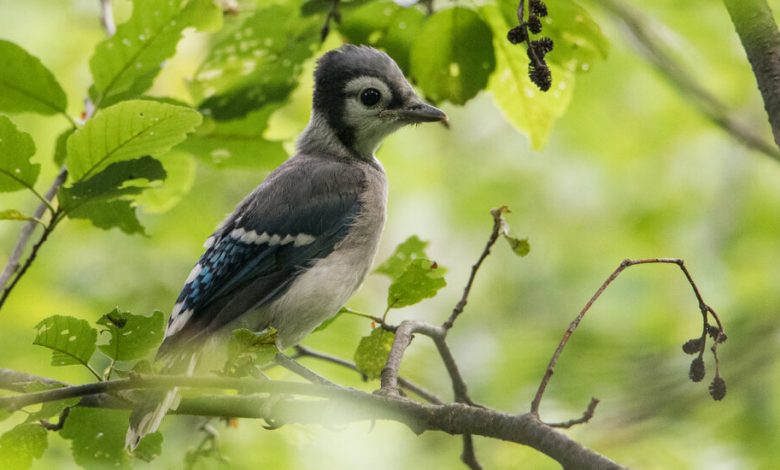Why ‘Birding With a Purpose’ Is What You Should Do This Spring

I am chasing weeds, crawling around in the cool, moist earth, in pursuit of thuggish green rosettes of garlic mustard. Not 20 feet away, another kind of chase is on, as one mourning dove pursues another with what looks like a vengeance.
The soil, and the days, are not all that’s heating up. So is breeding season, the birds are showing me, each species in its own time and style.
A male Northern cardinal close by is less pushy than the mourning dove. In a gesture that, through the filter of human perception, could be described as tender, he offers a female a sunflower seed from the ground. She accepts.
I am charmed. But more than that, I am called to action by these courtship behaviors and other, subtler ones pulsing all around me. The birds’ antics are an invocation to tune in — and to bear witness, in an official, purposeful way.
This spring, I’m not just casually watching the birds while gardening. I am “Atlasing,” noting any breeding behaviors I observe and sharing them, as part of New York State’s third Breeding Bird Atlas. Like parallel surveys in many other states, this is a five-year-long undertaking conducted every 20 years to give conservation decision makers the information they need about bird populations and locations.
And gardeners can help.
“Anybody who has a robin’s nest in their yard can contribute to the Atlas,” said Kathryn J. Schneider, an ornithologist who is a chair of the steering committee and a lifelong gardener. “It’s birding with a purpose — a chance to make a contribution to conservation.”
It is also a chance to learn about the lives of birds, sharpening our observation skills along the way. And isn’t that the best part of gardening — the way it connects us to the wider world?
Breeding Bird Atlas Basics
Breeding bird atlases originated in Britain in the 1960s. New York State, where about 245 species of birds breed, conducted its first in 1980-85. The current one, funded by federal aid with some donations, started in 2020, so it is close to the halfway mark.
To make a monumental task more manageable, the area to be surveyed is broken into chunks called blocks. In New York, that amounts to 5,710 areas of roughly nine square miles each.
Atlasing is “a different kind of birding, with a learning curve,” said Julie Hart, of the New York Natural Heritage Program, who is the project coordinator for the current Atlas.
Looking at the Atlas website or the corresponding version in the eBird app, you quickly realize the truth of that, even if you’re accustomed to counting birds and making lists to share on eBird, the portal managed by Cornell Lab of Ornithology and used by hundreds of thousands of birders worldwide. When you’re making lists — 11 goldfinches, six white-throated sparrows, four blue jays — the presence of the birds is the key criterion.
But the Atlas is not a mere head count. The data collected — through a portal on eBird, for the first time, rather than using paper checklists — includes who the birds are and what breeding behavior they’re up to, along with the usual when and where of any sighting.
Stop, Look, Listen
“Atlasing makes people notice more about birds,” said Dr. Schneider, the author of “Birding the Hudson Valley,” about the lives of the region’s birds and where to see them. “You have to really watch them — not, ‘Oh, it’s a robin,’ but what it does.”
To that end, there are 23 behavior codes to choose from, to qualify each entry recorded.
For example: C, for courtship behavior. That’s how I marked my cardinals and that insistent mourning dove chasing his target. A week later, I checked P, for pair (as in, they’d paired up), when I saw two doves, side by side, preening — nuzzling and almost nibbling the feathers at each other’s head and neck.
There has also been a lot of S, for singing bird, going on. That includes the male Eastern Phoebe who arrived in the second half of March and soon began to emphatically, incessantly speak his own name. (The free app Merlin, and another from Audubon, can help with song identification.) More melodious early voices have included the cardinal (the female sings, too), bluebirds and the Carolina wren.
Could you call those eccentric vocalizations the gray catbird makes a song? A fledgling Atlas-er, I wasn’t sure, until Ms. Hart told me yes. She also advised me to watch for catbirds with their beaks stuffed full of twigs and grasses. Like American robins, they don’t carry a single twig to the nest site, but mouthfuls at a time. (Code: CN, for carrying nest material. But if a bird is sighted in the process of constructing a nest, use NB, for nest building.)
Such sightings (or those of adults carrying food to feed their nestlings, noted as CF) are the best clues for getting to know your new neighbors.
“It’s great fun to try to figure out where the birds are nesting,” Dr. Schneider said. “If I see that catbird diving into a bush with a mouthful of material, or later with food, I go and look there.”
Seeing would-be parents carrying nesting materials also feels like an extra affirmation of the ecological value of a less fastidious, delayed spring cleanup. Gardeners are being advised more emphatically lately to “leave the leaves” in fall, and delay or skip spring cutback of perennials, to support beneficial insects and other arthropods who overwinter in them.
More surviving insects in the leaf litter is good news for songbirds, most of whom are at least partly insectivorous, with moth caterpillars, in particular, the preferred baby food. But now, as bits of garden “debris” fly by, being upcycled into nurseries, it is almost as if the practice is having an unintended bonus. (Here are some additional tips for making a bird-friendly garden.)
Shopping for the Dream Home
In the case of those chatty little house wrens, with their messy, twig-stuffed nests in birdhouses and other cavities, it’s all about the real estate. And lots of it, Ms. Hart said.
Males who have claimed a territory start not one but several dummy or trial nests to attract a female, who says yes not just to him but to one of the proposed locations — which she then completes.
“It’s like shopping for a house: You see a lot, then decide which you like best,” Dr. Schneider said. “You can think, ‘Oh, I found a nest,’ and then that’s not where they build it.”
No marking house wrens with the NB code, therefore, the Atlas guidelines explain. Likewise, no NB for woodpeckers, who are cavity nesters that may excavate more than one possibility before settling down.
In the Albany area, where Ms. Hart is based, “the woodpeckers have, for the most part, paired up for the season,” she said. But first, there was the late-winter fighting phase, which she described as “superaggressive.”
“It’s almost like a game of hide-and-seek on opposite sides of a tree trunk,” she said, “fighting to see who gets a female.” Feathers may literally fly, as one bird pulls them from a competitor.
My Apologies, Dear Tree Swallow
Before too long, I hope to have the chance to mark a mourning dove, blue jay or cardinal nest as ON (for occupied nest) and then NE (nests with eggs), and to observe the birds feeding their young (FY). And if all goes well, to finish with FL (for recent fledglings).
I know from decades of breeding seasons that there will be at least one chance to mark someone with an A — and not for excellence, but for agitated behavior. That code notes an anxious parent’s response to a predator approaching a nest. Later this spring, I will be divebombed and twittered at by this year’s tree swallow in a nest box badly sited along the shortest route to the compost heap.
Would you recognize the courtship display of a hummingbird? “It’s a huge, swooping figure-8 flight display,” Ms. Hart said. Males will show off, often right by a feeder, while making lots of their own twittering sounds.
Some inferences may be drawn from what you don’t see, too. For instance, no goldfinches are carrying nesting material or exhibiting other breeding behaviors right now. They are an exception who breed later, to coincide with the summertime availability of thistledown used as nest lining.
All of this has all been right in front of me in the garden every spring, and I took some details in. But thanks to my Atlas adventure, I’m putting more of the pieces together, focused and energized by the idea of doing something worthwhile.
Think about this, as that Phoebe builds its nest under your porch overhang or a male yellow warbler sings: For the next 20 years, what we contribute now will be the most up-to-date information available for scientists and policymakers to draw upon.
“The Atlas contributions will live longer than me,” Dr. Schneider said, “guiding conservation in the state long after that.”
Margaret Roach is the creator of the website and podcast A Way to Garden, and a book of the same name.
For weekly email updates on residential real estate news, sign up here. Follow us on Twitter: @nytrealestate.






